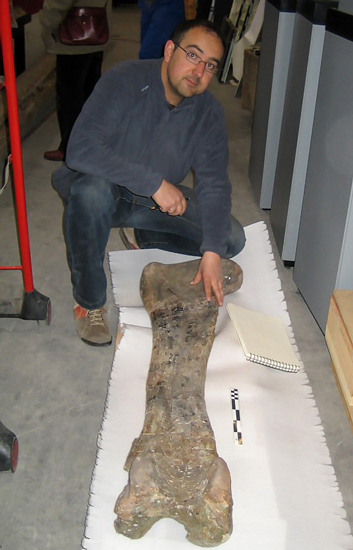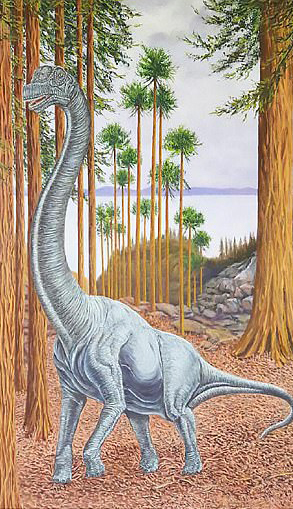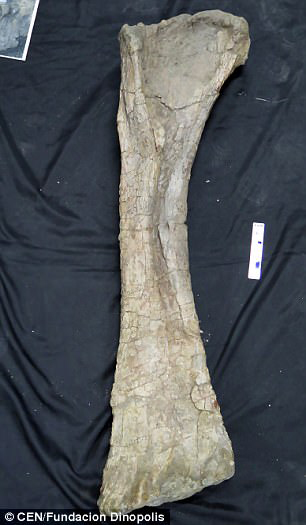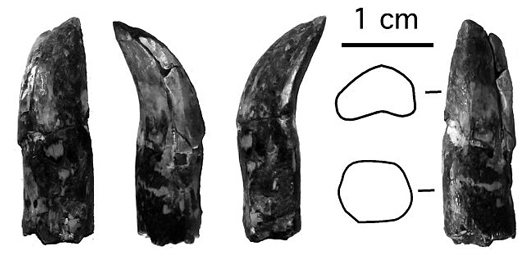Europe’s Newest Brachiosaur is Described in a New Paper
Soriatitan golmayensis of the Lower Cretaceous of Spain
Say hello to Europe’s newest member of the Brachiosauridae family – Soriatitan golmayensis, a sauropod estimated to have been longer than a badminton court! This new species of herbivorous dinosaur has been described in a scientific paper published in the journal “Cretaceous Research”. The fossil material, consisting of a single tooth, elements from the hips, limb bones including a partial femur and fragmentary tail bones were excavated over several years from the turn of the century. The study of the fossil material finally culminating in the establishment of a new species of brachiosaurid.
Soriatitan golmayensis
The genus name means “Soria Titan”, a reference to Soria Province in central Spain where the fossils come from. The species name honours the Lower Cretaceous Golmayo Formation (upper Hauterivian-lower Barremian), from which the fossil material was extracted.
An Illustration of the Newly Described Early Cretaceous Sauropod Soriatitan golmayensis
Picture credit: Fundación Conjunto Paleontológico de Teruel-Dinópolis
Approximately Fourteen Metres Long
With less than 15% of the skeleton to work with, the researchers, which included lead author of the paper, Rafael Royo-Torres (Fundación Conjunto Paleontológico de Teruel-Dinópolis/Museo Aragonés de Paleontología, Spain), were able to identify this dinosaur as a brachiosaur by comparing the bones to better-known species. To estimate the size, the scientists scaled up the dinosaur based on the dimensions of the 1.25-metre-long humerus (upper arm bone). When this bone was compared to the humeri of other brachiosaurids the team concluded that their specimen represented a fourteen-metre-long individual.
The Size of Soriatitan Was Calculated Using the Humerus
Picture credit: Fundación Conjunto Paleontológico de Teruel-Dinópolis
The Brachiosauridae Family
Brachiosaurs probably originated in the late Middle Jurassic and survived the break-up of Pangaea before finally becoming extinct in the Early Cretaceous. Fossils of these long-necked, heavy-limbed plant-eaters are known from North America, Africa, Europe and southern England. The Brachiosauridae is one of the three groups that make up the larger clade the Titanosauriformes.
The research team estimate that Soriatitan roamed the Iberian Peninsula some 132 million years ago. Although, other fragmentary fossils notably those of Pelorosaurus conybeari from the Grinstead Clay Formation (West Sussex, England), have been tentatively assigned to the Brachiosauridae, the discovery of Soriatitan is extremely significant. Dinosaurs such as the similar sized P. conybeari have been found in slightly older strata (Valangian faunal stage of the Early Cretaceous), Soriatitan provides evidence that brachiosaurids persisted in the Early Cretaceous of Europe for longer than previously thought.
Palaeontologist Rafael Royo-Torres explained:
“Until now it was believed that brachiosaurids had become extinct in Europe around 130 million years ago, the discovery of Soriatitan changes our perception of the European Early Cretaceous biota.”
The Break-up of Pangaea
The single, spoon-shaped tooth is typical of a brachiosaurid. This tooth and the shape of a number of bones such as the presence of middle caudal neural spines helped the researchers to assign this dinosaur to the Brachiosauridae family. In addition, the team deduced that Soriatitan may have been closely related to Abydosaurus, Cedarosaurus and Venenosaurus, which are all known from Lower Cretaceous-aged strata from Utah (United States).
The presence of Early Cretaceous brachiosaurids in both North America and Europe, give support to the hypothesis of a connection between the tectonic plates of these continents at some point during the Early Cretaceous. A land connection between Europe and North America must have been present to enable closely related dinosaurs to be found in both Spain and the western United States.
Views of the Single Tooth of Soriatitan golmayensis
Picture credit: Fundación Conjunto Paleontológico de Teruel-Dinópolis
The Evolution of the Titanosauriformes in Europe
The discovery of Soriatitan, may help palaeontologists to better understand the evolution of the Titanosauriformes in Europe. Rafael Royo-Torres was part of the research team that described the non-brachiosaurid titanosauriform Tastavinsaurus sanzi recovered from a dig site in Peñarroya de Tastavins (Teruel) at the base of the marine Xert Formation in 2008. It is one of the most complete and best-preserved sauropod dinosaur skeletons from the European Early Cretaceous. Tastavinsaurus roamed Spain some 125 million years ago. The discovery of Soriatitan may help fill the evolutionary gap between Late Jurassic brachiosaurs and the European titanosaurs of the Early Cretaceous.
Rafael Royo-Torres Photographed Next to the Partial Femur (Thigh Bone)

Palaeontologist Rafael Royo , lead author of the scientific paper examines a Soriatitan golmayensis femur.
Picture credit: Fundación Conjunto Paleontológico de Teruel-Dinópolis




